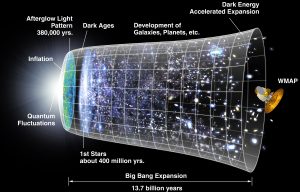I believe that this question has been answered on the Physics Stack Exchange. 13.7 years in the past the…
Select :
AsteroidsBlack HolesCareers in AstronomyCelestial EventsCometsConstellationsCosmic DistancesCosmic Microwave BackgroundCosmologyExoplanetsGalaxiesGravity WavesHoaxesMoonPhysicsPlanetsRadio AstronomyScientific MethodSETISolar SystemSpace ProbesStarsSunTelescopesUnexplained Celestial Observations

What was the Intensity of the Cosmic Background Radiation Just After Recombination?
Since the cosmic microwave background emits as a black body, we start with the spectral radiance of a black…
At What Distance Does the Intensity of a One Million Watt Transmitter Equal That From the Cosmic Microwave Background?
Question: If there was a 1,000,000 watt UHF television show broadcast into space, at what distance would it become…
Alternate Theories for the Expansion of the Universe
Question(s): I have three related questions: The redshift of objects indicates that the farther away they are, the faster…
Inconsistency Between the Age and Diameter of the Universe?
Question: I have read that the diameter of the universe is 96 billion light years. How can that be…
What is the Flux Density of the Cosmic Microwave Background?
Question: The temperature of the CMB is about 3 Kelvin, but the 3 K here mean the brightness temperature…





